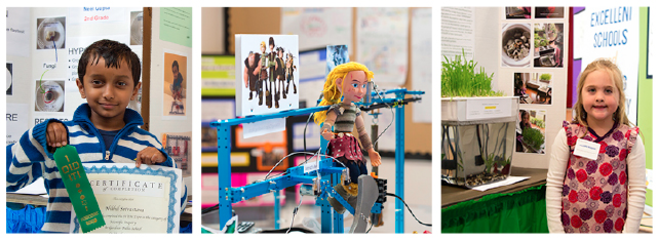
LASD’s Elementary School STEM Expos capture the imaginations of students, teachers and parents
Students are naturally curious about the world and the LASD STEM Expos provided the perfect opportunity to explore and experiment. Students actively engaged in realistic problem solving with the application of science, technology, engineering and mathematics. Business leaders, educators, industry experts and others are rallying around the importance of STEM in early education.
Launched 4 years ago with funding from LAEF, the LASD STEM program is now recognized nationally for its exciting, well-integrated student centered projects.
- Every elementary school has a STEM teacher and a STEM lab where students in all grades actively engage in solving problems through hands-on experiences.
- Every elementary school has a MakerSpace, equipped with tools and supplies for students to create, invent and learn with their friends during lunchtime.

LASD Students Build Robots in STEM Lab
- New this year, LASD has expanded the elementary school robotics program, which now includes 2nd-5th graders. Some examples of the robots students create include: a Bristlebot using a small motor, a Jitterbug run by solar energy, an Innovativebot and an Ambot with 4 motors and a breadboard.
.png)
LASD students are exploring real world problems. The bee population around the globe is dwindling, according to a study by Yale University, and scientists and students across the country are exploring possible solutions. For example, Anna Haldewang at Savannah College of Art and Design created a drone that mimics the way insects cross-pollinate our crops. New this year, LASD students are now exploring solutions to this problem by using their engineering skills to design their own pollinators. Learn more about this exciting new project from LASD STEM teacher Katie Farley.
___________________________________________________________________
Here’s an example of what LASD students are learning in STEM lab this year:
- Kindergartens create BeeBot City, a student designed community made from cardboard boxes and platforms that BeeBot (a programmable robot) can “drive” through.
- 1st Graders create Kites or Umbrellas. Building on their science unit about weather, students use the engineering process to design for wind, rain or sun.
- 2nd Graders learn about the Global Pollination Crisis. Students use their engineering skills to design and build a pollinator out of recycled materials.
- 3rd Graders explore Bird Adaptations and use this experience to create their own unique species of bird by drawing, building, sculpting or programming in Scratch.
- 4th Graders investigate Survival Human Impact. Students learn about a natural disaster and its impact on people. By applying the design thinking process they prototype solutions that can protect humans in the future.
- 5th Graders design a Makey Makey and Scratch project. Students use their knowledge of a content area to create a physical model. They also design a computer program in Scratch to provide information and ask questions of the user about the content area. These two components are connected with a Makey Makey to become and interactive learning tool.
- 6th Graders tackle the Popsicle Challenge. Students use their knowledge of energy transfer and engineering skills to design a container that will fit in their backpack and keep a popsicle frozen for an hour and a half.
LAEF’s annual grant is the leading source of funding to make STEM a reality in our schools. Thank you to our LAEF donors for contributing this school year.
For technical questions and comments regarding this website, including accessibility concerns, please contact the Webmaster. Back to Top

.png)